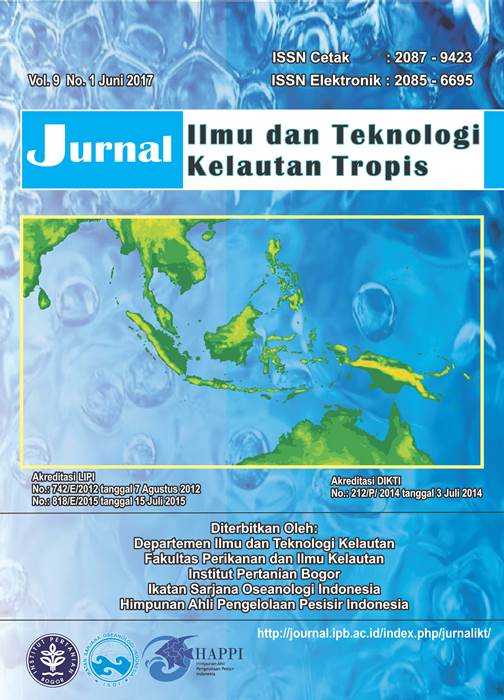BIODIVERSITY OF REEF FISHES IN MARINE PROTECTED AREA OF KARIMUNJAWA NATIONAL PARK
Abstract
Karimunjawa National Park (KNP) has a high diversity of coral reef and fish. This study is aimed to analyze the biodiversity of reef fish in KNP. Field survey was conducted in KNP, District of Jepara, Central Java, in April-Juni 2015. Primary data was obtained by using survey and observation method, includes the number of reef fish individuals per family, coral cover, turbidity, total nitrogen (N), and PO4. Secondary data were obtained from KNP authority. Belt transect method was used for counting the number of reef fish individuals, while coral cover was measured using line intercept transect (LIT) method. Abundance and biomass of reef fishes were analyzed descriptively, followed by cluster analysis. The results indicated that the average of coral cover in 2015 was 44.70%. The highest coral cover was in Taka Malang with 65.65% and the lowest was in Nirwana with 35.45%. The reef fish’s abundance in 2015 was dominated by Pomacentridae (60.46%) with an abundance of 14,850 no/ha, the second position was Caesionidae (11.77%) with an abundance of 2,892 no/ha, the third was Scaridae (6.27%) with an abundance of 1,540 no/ha. The highest biomass in 2015 was Scaridae (122.33 kg/ha), the second order was Caesionidae (104.91 kg/ha), and the third was Serranidae (50.80 kg/ha). Reef fish biodiversity in KNP is considering properly maintained, as demonstrated by high abundance and biomass of fish families.
Keywords: biodiversity, reef fish, Karimunjawa, marine protected area
Authors
This work is licensed under a Creative Commons Attribution 4.0 International License.
Jurnal Ilmu dan Teknologi Kelautan Tropis i is an open-access journal, meaning that all content is freely available without charge to the user or their institution. Users are allowed to read, download, copy, distribute, print, search, or link to the full texts of the articles in this journal without needing to request prior permission from the publisher or the author.
All articles published by Jurnal Ilmu dan Teknologi Kelautan Tropis are licensed under the Creative Commons Attribution 4.0 International License. This allows for unrestricted use, distribution, and reproduction in any medium, provided proper credit is given to the original authors.
Authors submitting manuscripts should understand and agree that the copyright of published manuscripts is retained by the authors. Copyright encompasses the exclusive rights of authors to reproduce, distribute, and sell any part of the journal articles in all forms and media. Reproduction of any part of this journal, its storage in databases, and its transmission by any form or media is allowed without written permission from Jurnal Ilmu dan Teknologi Kelautan Tropis.


